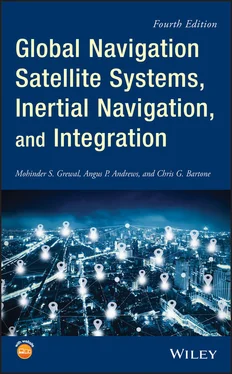For details of our global editorial offices, customer services, and more information about Wiley products visit us at www.wiley.com.
Wiley also publishes its books in a variety of electronic formats and by print‐on‐demand. Some content that appears in standard print versions of this book may not be available in other formats.
Limit of Liability/Disclaimer of Warranty
MATLAB® is a trademark of The MathWorks, Inc. and is used with permission. The MathWorks does not warrant the accuracy of the text or exercises in this book. This work's use or discussion of MATLAB® software or related products does not constitute endorsement or sponsorship by The MathWorks of a particular pedagogical approach or particular use of the MATLAB® software. While the publisher and authors have used their best efforts in preparing this work, they make no representations or warranties with respect to the accuracy or completeness of the contents of this work and specifically disclaim all warranties, including without limitation any implied warranties of merchantability or fitness for a particular purpose. No warranty may be created or extended by sales representatives, written sales materials or promotional statements for this work. The fact that an organization, website, or product is referred to in this work as a citation and/or potential source of further information does not mean that the publisher and authors endorse the information or services the organization, website, or product may provide or recommendations it may make. This work is sold with the understanding that the publisher is not engaged in rendering professional services. The advice and strategies contained herein may not be suitable for your situation. You should consult with a specialist where appropriate. Further, readers should be aware that websites listed in this work may have changed or disappeared between when this work was written and when it is read. Neither the publisher nor authors shall be liable for any loss of profit or any other commercial damages, including but not limited to special, incidental, consequential, or other damages.
Library of Congress Cataloging‐in‐Publication Data
Names: Grewal, Mohinder S., author. | Andrews, Angus P., author. | Bartone,
Chris G., author. | John Wiley & Sons.
Title: Global navigation satellite systems, inertial navigation, and
integration / Mohinder S. Grewal, California State University at
Fullerton, Angus P. Andrews, Chris G. Bartone.
Description: Fourth Edition. | Hoboken : Wiley, 2020. | Third edition
published 2013. | Includes bibliographical references and index.
Identifiers: LCCN 2019038560 (print) | LCCN 2019038561 (ebook) | ISBN
9781119547839 (Hardback) | ISBN 9781119547846 (Adobe PDF) | ISBN
9781119547815 (ePub)
Subjects: LCSH: Global Positioning System. | Inertial navigation. | Kalman
filtering.
Classification: LCC G109.5 .G74 2020 (print) | LCC G109.5 (ebook) | DDC
910.285‐‐dc23
LC record available at https://lccn.loc.gov/2019038560
LC ebook record available at https://lccn.loc.gov/2019038561
Cover design by Wiley
Cover image: © Busakorn Pongparnit/Getty Images
M.S.G. dedicates this book to the memory of his parents, Livlin Kaur and Sardar Sahib Sardar Karam Singh Grewal.
A.P.A. dedicates his contributions to his wife Jeri, without whom it never would have happened.
C.G.B. dedicates this work to his wife Shirley and two sons, Christopher and Stephen, for their never‐ending support over the years.
Preface to the Fourth Edition
This book is intended for people who need a working knowledge of Global Navigation Satellite Systems (GNSS), Inertial Navigation Systems (INS), and the Kalman filtering models and methods used in their integration. The book is designed to provide a useable, working familiarity with both the theoretical and practical aspects of these subjects. For that purpose we have included “real‐world” problems from practice as illustrative examples. We also cover the more practical aspects of implementation: how to represent problems in a mathematical model, analyze performance as a function of model parameters, implement the mechanization equations in numerically stable algorithms, assess its computational requirements, test the validity of results, and monitor performance in operation with sensor data from GPS and INS. These important attributes, often overlooked in theoretical treatments, are essential for effective application of theory to real‐world problems.
The companion Wiley website ( www.wiley.com/go/grewal/gnss) contains MATLAB® m‐files to demonstrate the workings of the navigation solutions involved. It includes Kalman filter algorithms with GNSS and INS data sets, so that the reader can better discover how the Kalman filter works by observing it in action with GNSS and INS. The implementation of GNSS, INS, and Kalman filtering on computers also illuminates some of the practical considerations of finite‐word‐length arithmetic and the need for alternative algorithms to preserve the accuracy of the results. If the student wishes to apply what she or he learns, then it is essential that she or he experience its workings and failings – and learn to recognize the difference.
The book is organized for use as a text for an introductory course in GNSS technology at the senior level or as a first‐year graduate level course in GNSS, INS, and Kalman filtering theory and applications. It could also be used for self‐instruction or review by practicing engineers and scientists in these fields.
This fourth edition has been updated to include advancements in GNSS/INS technology since the third edition in 2013, as well as many improvements suggested by reviewers and readers of the second edition. Changes in this fourth edition include the following:
1 Updates on the significant upgrades in existing GNSS systems and on other systems currently under advanced development.
2 Expanded coverage of basic principles of antenna design and practical antenna design solutions are included.
3 Expanded coverage of basic principles of receiver design, and an update of the foundations for code and carrier acquisition and tracking within a GNSS receiver.
4 Examples demonstrating independence of Kalman filtering from probability density functions of error sources beyond their means and covariances, and how this breaks down with nonlinearities.
5 Updated coverage of inertial navigation to cover recent technology developments and the mathematical models and methods used in its implementation.
6 Updated dynamic models for the propagation of inertial navigation errors, including the effects of drifting sensor compensation parameters and nonlinearities.
7 Greatly expanded coverage of GNSS/INS integration, including derivation of a unified GNSS/INS integration model, its MATLAB implementations, and performance evaluation under simulated dynamic conditions.
The companion Wiley website has also been augmented to include updated background material and additional MATLAB scripts for simulating GNSS‐only and integrated GNSS/INS navigation. The companion website ( www.wiley.com/go/grewal/gnss) includes satellite position determination, calculation of ionospheric delays, and dilution of precision.
Chapter 1provides an overview of navigation in general, and GNSS and inertial navigation in particular. These overviews include fairly detailed descriptions of their respective histories, technologies, different implementation strategies, and applications.
Chapter 2covers the fundamental attributes of satellite navigation systems in general, the technologies involved, how the navigation solution is implemented, and how satellite geometries influence errors in the solution.
Читать дальше












